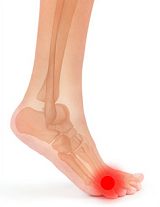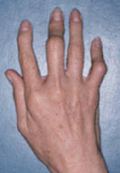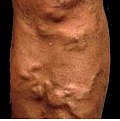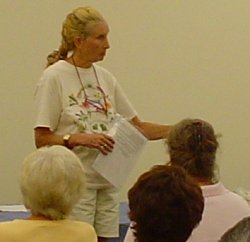Poor Circulation in Hands, Legs and Feet - Page 2
The extremities of the body are often one of the first places a person notices that they have a circulation problem. It actually affects the blood flow throughout the whole body, but here it is most noticeable.
Do you spend a lot of time standing up at work?
 Standing and sitting at work for long periods at a time, can be a potential health risk. Rory O'Neill from the UK's Hazards magazine, has some very interesting statistics as regards this.
Standing and sitting at work for long periods at a time, can be a potential health risk. Rory O'Neill from the UK's Hazards magazine, has some very interesting statistics as regards this.
It is estimated that as much as 11 million UK workers alone - approximately half the UK workforce - could be facing health risks from prolonged standing and as much as 2 million sick days a year result from lower limb disorders.
Do you fall into either of these categories?
Leg pain and foot pain
Consider that if you spend most of the day on your feet, some of the potential health risks include cold hands, cold feet, varicose veins, swollen ankles and feet, swollen veins, skin discolouration, leg pain, foot pain, aching bones and joints.
 Standing all day at work may also increase hypertension. Hypertension is also associated with standing for long hours at a time and people who have to do this, need to ensure they take regular breaks and change their body position by sitting down.
Standing all day at work may also increase hypertension. Hypertension is also associated with standing for long hours at a time and people who have to do this, need to ensure they take regular breaks and change their body position by sitting down.
Some recent studies have suggested that standing is good for you compared with sitting. This makes some sense, but the key thing is the length of time in either position.
Whether you stand up a lot or sit down a lot, you should change your position regularly and stretch your legs a bit every hour or two. The human body doesn't cope well with being in the same position hour after hour.
Prolonged sitting can also cause circulation problems
Prolonged sitting can bring with it just as many potential health risks as prolonged standing. Here are some of the more well-known symptoms of prolonged sitting. Most of us have experienced these on a long train or bus or plane journey, but for those people who have to sit in pretty much the same position for long periods of time, they may well be more familiar with these:
- Restricted flows to extremities resulting in poor circulation in hands and feet.
- Cold feet/cold hands due to restricted blood flow.
- Muscular aches, strains and cramps.
- Pins and needles.
- Restricted flows throughout the body.

Tips to Improve this condition at work:
Take regular breaks
If you are in a prolonged standing position or a prolonged sitting position, take regular breaks and move your arms or legs. Take a short walk, do some leg or arm exercises, on the spot walking/running, or take a walk outside the workplace. Get your blood pumping right to your extremities. Minimally, shake your hands and arms and circle your feet.
Improve blood flow with exercise
Try to take a walk at lunchtime, even if it is a short walk, around the block, around the outside of the workplace, up and down the stairs a few times, it is important to get the fluids flowing freely around the body. If you have been standing for a long period of time, raise the legs if possible.
Avoid restrictive clothing
Try to avoid wearing tight clothing that may restrict your feet. This includes socks that may be too tight, belts that may be too tight and also under garments that could also restrict blood flow.
Wear comfortable shoes at work
Wear shoes that really feel comfortable, especially if you are on your feet for long hours at a time. If you have to wear heels to work, then wear sports shoes to and from work and carry your work shoes with you to increase your circulation at least to and from work. If you get off a stop early so you have to walk a bit further to work, then do so at least a couple of times a week. This will give you more exercise and also more oxygen to the extremities.
Try and go for a 10 minute walk or longer each day. This increases oxygen being inhaled and pumps the blood faster into the extremities. This can help to remove waste products from cells even faster and may also help to strengthen the heart. If you are fortunate enough to have a gym bike at your workplace, use it!
Drink plenty of fresh Water each day
Working outside may increase the need for a regular intake of water. It is estimated that an adult should drink between 1.5 and 2 litres of water a day.
Drinking plenty of fresh water daily helps to hydrate cells including the skin, aids digestion and gives one a regular supply of minerals. Drinking water also helps the body to get rid of waste products.
Taking breaks and exercising regularly is an excellent way of improving health. Making sure you don't eat high fat foods when you have to sit down all day is important. If you eat high fat foods without exercising, you increase the chances of clogging up the arteries.
It is a well-publicised fact that the solid or saturated fat in our diet can contribute to a build up of cholesterol deposits or plaque in our arteries. If we eat too much saturated fat in our diets, the efficiency and health of our veins and arteries system may well suffer.
Keep your feet and hands warm
Wearing proper clothing for your extremities can make a huge difference to body warmth. If you are sitting or standing for long periods, make sure your feet are warm, especially if you are outside. Warm, dry footwear is a must for helping to maintain one's body temperature.
If your hands get cold at work and the heating provided is not warm enough, then finger-less gloves may help to remedy this.
During winter months, wearing thermal under vests and garments can make a huge difference to maintaining a warm body temperature.
Exercises that help promote good blood flow
There are many great ways to exercise: swimming, playing tennis, walking, jogging, netball, hockey etc. You can even join a local rambles society or cycling group. The health benefits of regular exercise can be enormous.
Use the stairs if possible
If you can use stairs instead of a lift at least part of the way, then do so. If you can avoid using a lift, then do so. Stairs really work the legs, raise temperature and get things moving internally.
Even doing some of these things a little each day can make a big difference.








